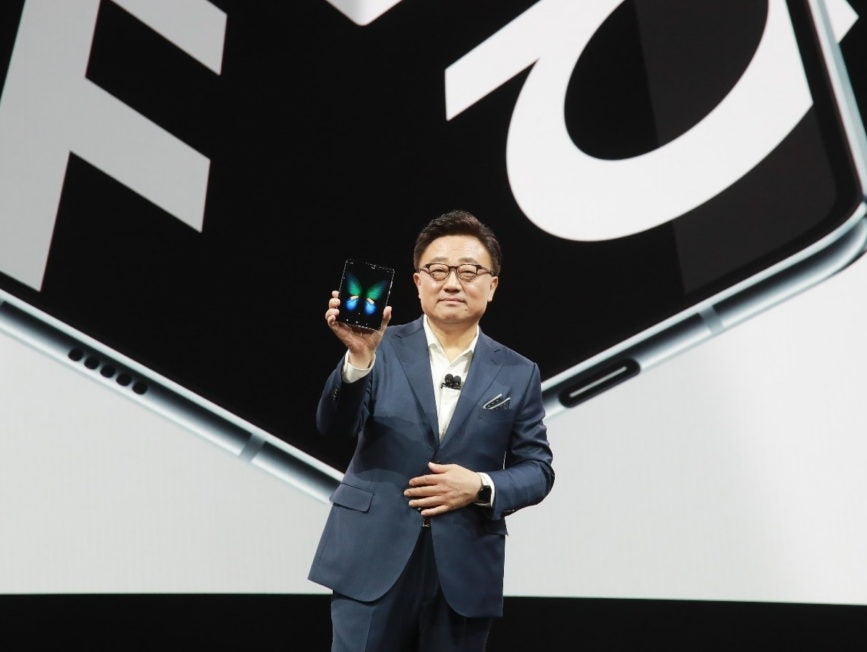
Despite the hype surrounding 5G technology, next-generation mobile networks have been overshadowed at the Mobile World Congress 2019 by foldable phones.
The announcement of Samsung’s anticipated foldable phone, the Galaxy Fold, at its recent Unpacked launch event came just ahead of Huawei’s Mate X. The devices are expected to launch in April and June respectively, giving consumers access to the long-awaited foldable phone concept.
LG has since showed off a dual-screen smartphone-tablet hybrid at MWC, while BlackBerry smartphone manufacturer TCL also plans to enter the market in 2020 with a budget foldable phone. Chinese firm Oppo is also poised to join the foldable phone market in the near future.
Should smartphone manufacturers be prepared for a slow start?
While smartphone manufacturers rush to get an early start on the technology, consumers are unlikely to shell out on the costly devices straight away.
“Samsung plans to release its Fold in April, with Huawei to follow in June with the Mate X, asking a higher price but also bringing the added hype sticker of 5G,” James Manning Smith, market analyst at Futuresource Consulting, said. “However, given that both handsets come with premium price points, they, like Royole’s Flexpai before them, will act more like proof of concept rather than genuine drivers of market growth.”
The Flexpai, released by flexible electronics company Royole, became the world’s first foldable smartphone when it released in China at the end of 2018. However, costing approximately $1,300, those reviewing the device all seem to agree that they expected more.
How well do you really know your competitors?
Access the most comprehensive Company Profiles on the market, powered by GlobalData. Save hours of research. Gain competitive edge.

Thank you!
Your download email will arrive shortly
Not ready to buy yet? Download a free sample
We are confident about the unique quality of our Company Profiles. However, we want you to make the most beneficial decision for your business, so we offer a free sample that you can download by submitting the below form
By GlobalDataWhile the latest flagship phones, like Apple’s iPhone X and Samsung’s recently announced Galaxy S10, have almost breached the $1,000 mark, the Galaxy Fold is set to launch at a price of $1,980, while the Huawei Mate X will set you back by as much as $2,600. Convincing consumers to shell out an additional $1,000 for a bigger screen might be an ask too big.
However, at this stage in the development of flexible screens, there isn’t much that manufacturers can do to reduce the cost of flexible phones in 2019.
“The higher manufacturing costs of flexible screens will result in smartphones retailing at highly premium prices,” Smith said. “While this is in part also the result of other technological innovations, not least 5G modems, commanding premium prices, the flexible screen presents a significant manufacturing cost to vendors.”
As a result, foldable phones are unlikely to become the new norm this year, despite the hype that the Galaxy Fold and Huawei Mate X have generated.
“This will inhibit mass adoption at launch, and it is likely that only enthusiastic early adopters with deep pockets will purchase flexible phones in 2019,” Smith said.
Foldable phones 2019? Maybe not, but there is promise
While manufacturers may have to wait for flexible phones to take off, the technology holds plenty of promise.
According to Smith, the aesthetics of a device are often the “primary trigger” for consumers when purchasing a new device. Folding screens will bring a long-awaited change to smartphone design that could prove to be important if it is to be anything more than a fad.
“Aesthetic appeal is a primary trigger for smartphone purchase,” Smith said. “Smartphone design has remained largely unchanged for the last decade, so a flexible screen offers the prospect of a move from the now common rectangle.
“It starts to build out a new set of USPs [unique selling points], which – if positioned correctly – could quickly capture the hearts and hands of consumers.”
According to leading phone retailer Carphone Warehouse, UK consumers typically replace their smartphones every two and a half years. While manufacturers may have to wait to see flexible screens achieve success, those in the smartphone market are certainly more likely to see widespread adoption faster than those manufacturing other devices that could benefit, such as tablets and television sets.
Foldable phones: A gamble for smartphone manufacturers
Smartphone screens, typically made from glass that is prone to shattering when dropped, currently pose one of the biggest problems for manufacturers and consumers. Using plastic screens will negate this problem somewhat, but the problems faced over the years will have done little to convince consumers that foldable screens, which will be repeatedly put under stress, will be able to withstand heavy use.
“While some breakages are inevitable, these will have to be minimised for consumers to wholeheartedly adopt flexible phones. Reliability and safety will have to be ensured from launch,” Smith said.
The pressure will be on Samsung and Huawei to convince consumers that flexible screens are able to deliver on their promise. Aside from added durability and less risk of shattering, these plastic displays also offer better water and dust resistance – all USPs that manufacturers should use to sell their new handsets.
“This [using plastic[ benefits both consumers and vendors, as the cost of replacing or repairing handsets under warranty decreases and consumers gain more confidence in their expensive device, confident that the tech can withstand whatever their day-to-day lives throw at them.”
However, while manufacturers are betting big on folding screens, it will ultimately be on consumers to convince them that it is worth continuing to invest in the technology. Otherwise, the foldable phone could quickly go the same way as the flip phone, slider phone and modular phone.
“Consumer demand for these devices is still unknown and only time will tell whether the demand is there.”
Read more: MWC: Qualcomm 5G chips target laptops, VR and… phones







